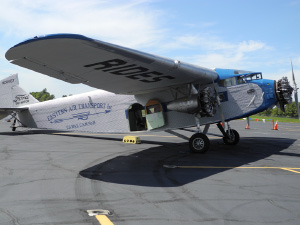
By Kenneth L. Kieser
Northeast News
October 1, 2011
Many thoughts occur while riding on an airplane made in 1929, like, will this plane stay in the air? How can a plane fly slowly enough to land without flaps? Why does this plane have automobile-style steering wheels with Ford printed where the horn should be?
These were three of my many thoughts while taxing down the runway at Lee’s Summit Airport in a 1929 Ford Tri-Motor made from corrugated aluminum alloy that resembled material from a metal roof usually found on barns. The Ford Motor Company mass produced 199 Tri-Motors from 1926 to 1933 and I was riding on one of the few survivors.
The Plane, aptly named “The Tin Goose,” was a marvel of its time. Original, leather covered chairs lined both sides of the fuselage. Each seat had a little light on the wall, closely resembling a night light close to a button labeled “Vent.” I twisted the vent button and could see daylight through the air slit where cool breezes had filtered through for 82 years.
Loud engine noise soon flooded the plane with a brief scent of burnt fuel that somehow escaped the incredibly powerful propeller wash. Three 450 horsepower Pratt and Whitney engines soon made a satisfyingly deep sound as we taxied. I felt amazingly safe as we slipped down the runway and smoothly lifted into a beautiful blue sky mixed with wisps of clouds. Once again, “The Tin Goose” was air born while its few siblings that survived sat in museums!
Ten passengers and two pilots quickly reached a couple thousand feet in the plane that was built when my grandfathers were young men and my dad was one year old. I sat in the front passenger seat for a closer look at the pilot and co-pilot trimming fuel feeds and turning an overhead crank to adjust elevators so the plane would stay stable while taking pressure off the controls. The pilot seemed satisfied with his settings and relaxed to cruise through space.
I quickly realized that this was one of the most unique moments in my life while watching “seat of the pants” flying firsthand in the world’s first mass produced passenger plane built by Henry Ford. I hoped no one in the immediate area could see the stupid grin plastered all over my face!! I noticed the pilot had a slight smile too.
“My day job is flying an Airbus A320 for Delta Airlines, a plane with the most modern technology in the world,” said pilot Colin K. Soucy. “I volunteer once a month to fly the Ford Tri-Motor around the country, a real joy. The wings are thick so the plane won’t go fast, but you get a lot of lift and it will fly in and out of short runways.
“The landing gear is welded down with fixed pitch propellers as opposed to variable pitch props that can change flight angles. This is totally different than flying jets, you just look out the window and fly.”
I glanced up at Captain Soucy and his co-pilot who sat several feet higher than the passenger cabin and noticed a hatch on the ceiling, a couple feet behind them that would allow an escape during emergencies, especially during forced water landings. This emphazed the careful thought that went into the plane’s design.
Henry Ford realized the potential for mass air transportation after World War I and helped design the “Tin Goose.” To overcome concerns of engine reliability, he specified three engines. The plane can fly on one engine in a emergency, and he conceived the closed cabin to keep passengers comfortable. The first Tri-Motors seated the pilot in an open cockpit, as many pilots of the time doubted a plane could be flown without direct feel of the wind.
The plane I rode in had its maiden flight on Aug. 21, 1929, and was purchased by Pitcairn Aviation’s passenger division, Eastern Air Transport, which later became Eastern Airlines. Cubana Airlines leased the plane to fly between Havana and Santiago de Cuba. Eventually the “Goose” was flown by the government of the Dominican Republic.
The plane returned to the United States in 1949 for barnstorming shows. By 1950 it was fitted with more powerful engines, two 450 hp and a 550 hp, and used as a crop duster, the most powerful engines ever on a Ford Tri-Motor. In 1955 the “Goose” was moved to Idaho and fitted with two 275 gallon tanks and bomb doors for use as a borate bomber for aerial firefighting. Further modifications turned this well-traveled airplane into a smoke-jumper’s flying platform.
The plane eventually moved to Lawrence, Kan., in 1964 for more barnstorming duty. During this period it had a variety of roles including the primary setting for the Jerry Lewis Comedy, “The Family Jewels.” By 1973 the “Goose” was still being used for air show rides when a storm flipped the plane over, badly damaging it. The Experimental Aircraft Association purchased the plane and took 12 years to restore it. The plane made Hollywood again in the 2009 Johnny Depp film, “Public Enemies.”
Today the Experimental Aircraft Association flies the “Goose” cross country to educate the public and give people the chance to fly on a legend. The cost is generally about $70 to pay for fuel and other costs so this extraordinary airplane will keep flying.
“Next we are flying to St. Louis,” Soucy said. “Flying the ‘Tin Goose’ across country is slow. We are going 90 miles per hour and have four hours of fuel. Of course, we have to land with fuel in the tank so that makes the hops even shorter. You are tired and fatigued and ready to get out of the airplane. By day’s end you are ready to have dinner. My goal is to fly the ‘Tin Goose’ on its 100th birthday!”
I believe he will!
I salute the Experimental Aircraft Association for making this sturdy plane available for rides. Certainly not all teaching is done in the classrooms and planes like the Ford Tri-Motor offer a glimpse of America’s history. I feel very fortunate to have flown on this well-traveled plane from my grandfather’s time!!!
SIDEBAR: Ford Tri-Motor Specs:
Max Cruise Speed 132 Passenger Capacity 10
Normal Cruise 80-100 Range 570 miles
Stall Speed 57 Rate of Climb 970 FPM
Length 49’10” Horsepower 450
Wing Span 74’8” Oil Capacity 8 gallons
Fuel Capacity 231 GAL Cabin Cu. Ft. 461’
For more information about future flights, call (877) 952-5395 or visit www.flytheford.org.


















